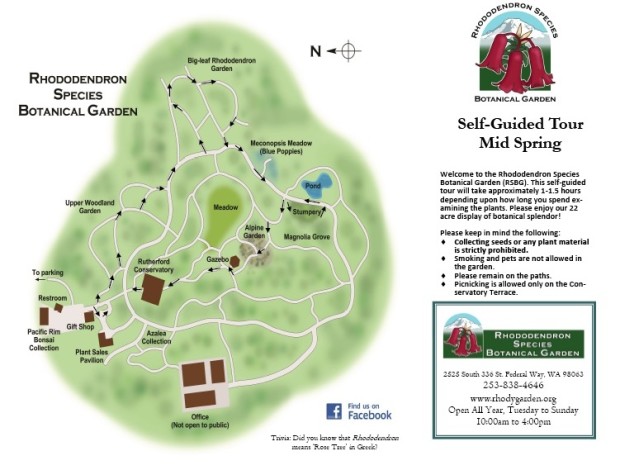Enter the courtyard and look to your right where you will see #1 Arisaema sikokianum*, Jack in the Pulpit. This strange-looking plant has a beautiful but unusual flower of dark purple and white. It is easily grown in the shaded garden. From the garden shop walk to your left and visit the clear pink-flowered #2 Rhododendron schlippenbachii, the Royal Azalea. This plant is famous for its beautiful flowers in early spring as well as the wonderful orange fall foliage color. Next to R. schlippenbachii is #3 Ribes sanguineum*, Flowering Currant. Native to the Northwest, this hummingbird favorite thrives in our cli-mate and is adaptable to almost any garden situation.
Take the left path between the two deciduous magnolia trees and you are in the Upper Woodland Garden which features many species with thickly indumented leaf undersurfaces. The magnolia on your right is #4 Magnolia sargentiana var. robusta from China. This pink flowering magnolia has among the largest flowers of any magnolia. This plant is fairly uncommon in cultivation despite the large flowers and nice foliage. The one on your left is #5 Magnolia hypoleuca from Japan. Its cup-shaped creamy white flowers appear in June and its huge leaves grow up to one and a half feet long!
Keep going and you will see #6 Luzula sylvatica ’Aurea’ Golden Wood Rush. The evergreen grass-like leaves of this plant are gold green in the spring, maturing to lime green at the end of the season adding wonderful color to a shady part of the garden. Next stop is a patch of #7 Coptis laciniata*, Goldthread on your left. This slow-spreading groundcover is native to the Pacific Northwest. The name comes from the golden yellow rhizomes that creep just beneath the surface of the ground. Continue straight ahead where you will see #8 Paeonia mairei on your left. This is a rare woodland species from the wild forests of China. This early spring-blooming peony enjoys shade unlike the common garden peony which requires full sun to thrive.
Let’s walk back to the main path and make a left turn. Keep going until you see #9 Rhododendron williamsianum* on your left. This popular species has attractive pink bell-shaped flowers followed by reddish-bronze new growth. Take the next left turn to visit the Big Leaf Garden. Most of the big-leafed rhododendrons eventually become very large trees in their native temper-ate rainforests in the Sino-Himalaya. Stay to the left and you will see #10 Rhododendron cinnabarinum* on your right. This blue-green leaved rhododendron is native to the Himalaya Mountains. The pendulous, tubular-shaped flowers are variable in color—from red to yellow, orange, and even bi-color.
Straight ahead you will see #11 Podophyllum pleianthum, the Asian May Apple. This is a beautiful woodland plant with umbrella-like foliage. The plant is used medicinally in its native China. You should now be veering slightly to the right and headed back toward the main path. Continue for-ward to #12 Matteuccia struthiopteris*, the Ostrich Fern. The new growth of the emerging fiddle-heads is very beautiful.
Follow the sign and you will see #13 Rhododendron rex* on both sides. This plant has extremely attractive shiny deep green foliage with a thick gray to buff indumentum beneath. In China, where it grows wild, it can attain heights of up to 45 feet. You will also see #14 Polygonatum, the Giant Solomon’s Seal*. This shade-loving plant produces arching stems with clusters of delicate white flowers dangling beneath the leaves. Back to the main path is #15 Primula denticulata*. This Himalayan species is known as the Drumstick Primrose and blooms for a long period each spring.
Now, make a left turn on the main path. You will see #16 Rhododendron huanum on your left. This species from China has strikingly colored flowers and new growth. Keep going until you see the Himalayan Blue Poppy meadow on your left. Check out the new growth of #17 Cardiocrinum giganteum* which looks similar to a shiny green hosta. This is the Himalayan Giant Lily which can grow to 12 feet tall with masses of six inch long fragrant flowers in June. The clusters of fuzzy leaves are the Blue Poppies*.
Keep going along the main path until you see the Hardy Fern Foundation’s Victorian Stumpery (#18) on your right. A stumpery is an English Victorian period garden design that romanticizes nature. The design uses tree roots and stumps placed on their sides or upside down creating a “Wild Scene” which is then planted with thou-sands of ferns and other woodland plants. Have a seat on the cut cedar-log bench at the top of the Stumpery and enjoy the view of the pond garden.
From the Stumpery, walk back along the main path toward the blue poppies and take an immediate left. Go up the hill and you will see #19 Rhododendron pachysanthum* to your left. This native of Taiwan is one of the finest foliage plants in the genus. Next stop is #20 Rhododendron pseudochrysanthum* also native to Taiwan. The flower color of this species varies from white to light pink. These are both superb slow growing garden plants with very attractive foliage.
Now, walk up the hill to the Alpine Garden (#21). Please take some time to explore this unique garden area. Most of the plants here are found at high altitudes in the mountains of Asia. Walk up toward the Gazebo as you see #22 Rhododendron russatum to your right. This dwarf alpine rhododendron has vivid dark purple flowers. In China, it grows wild in various alpine habitats from 11,000 to 14,000 ft. The plant that surrounds the Gazebo is #23 Rhododendron degronianum ssp. yakushimanum which is found only on the very top of an ancient volcano on Yaku Island, Japan. Come back in early May to see the impressive floral display of this species.
Follow the sign for the Rutherford Conservatory (a separate self-guided handout is available to tour the Rutherford Conservatory). From here, you can walk back to the Visitor Center where you started. Many of the plants you viewed to-day are available in the RSBG Nursery but are quite rare in regular retail nurseries. We hope you enjoyed the self guided tour today. Please come back and visit the garden soon!
* For sale at RSBG Nursery

